Artillery in Ireland: Northern Ireland, Ardglass, Armagh, Ballinamuck, Bangor, Belfast, Derry, Downpatrick, Grey Point Fort, Lisburn, and Newry
Artillery preserved in Northern Ireland:
Ardglass, Armagh, Ballinamuck, Bangor, Belfast, Derry, Downpatrick, Grey Point Fort, Lisburn, and Newry
The aim of this website is to locate, identify and document every historical piece of artillery preserved in Ireland. Many contributors have assisted in the hunt for these guns to provide and update the data found on these web pages. Photos are by the author unless otherwise credited. Any errors found here are by the author, and any additions, corrections or amendments to this list of Guns and Artillery in Ireland would be most welcome and may be e-mailed to the author at [email protected].
Ardglass, County Down, Northern Ireland

(Alan Wright Photo)

(Ardfern Photo)

(Ck234 Photo)
Cast Iron Smoothbore Muzzleloading Gun, at the junction of Quay Street and Kildare Street, Jordan's Castle. This cannon is from a French ship sent to supply guns to the United Irishmen, wrecked off Ardglass.

(Alan Wright Photo)
Cast Iron Smoothbore Muzzleloading gun, mounted on a wooden naval gun carriage, Ardglass Golf Club, Castle Place.

(Ardfern Photo)

(Alan Wright Photo)
Cast Iron 32-pounder 17-cwt Smoothbore Muzzleloading Carronade with a Blomefield pattern breeching ring, mounted on a wooden naval gun carriage, No. 1 of 4, Ardglass Golf Club, Castle Place. The guns have periodically been rearranged in sequence, right to left.
Cast Iron Smoothbore Muzzleloading Gun, mounted on a wood naval gun carriage, No. 2 of 4, Ardglass Golf Club, Castle Place.
Cast Iron Smoothbore Muzzleloading Gun, mounted on a wood naval gun carriage, No. 3 of 4, Ardglass Golf Club, Castle Place.

(Ardglass Golf Club Photo)
Cast Iron Smoothbore Muzzleloading Gun, mounted on a wood naval gun carriage, No. 4 of 4, Ardglass Golf Club, Castle Place.
Armagh, County Armagh, Northern Ireland




(Internet Photos)
Russian Cast Iron24-pounder Smoothbore Muzzleloading Gun, (Serial No. 907), B:179.30, 1808, on the left trunnion, possibly by Foullon at Alexandrovski, with double-headed Eagle on the barrel, mounted on an iron garrison gun carriage. This gun is a war trophy from the Crimean War, 1854-1855.
Ballinamuck (Irish: Béal Átha na Muc, meaning 'mouth of the pig's ford') is a village in the north of County Longford in the Midlands of Ireland. It is around 15 km north of Longford Town. It was the scene of the Battle of Ballinamuck, where a combined Franco-Irish army aiding the United Irishmen rebellion of 1798 was defeated. The French soldiers were eventually repatriated. The Irish prisoners were taken to St Johnstown - today's Ballinalee - where they were executed in what is known locally as Bullys Acre and buried there. Ballinamuck is twinned with the French town of Essert.

(Artillery Club of Ireland Photo)
At three o’clock on the afternoon of 22 August 1798, three ships dropped anchor at Kilcummin about five miles north of Killala. Immediately, about a thousand men of a French expeditionary force, commanded by General Humbert, began to disembark bringing with them guns, ammunition and supplies. Thus started a military campaign which lasted for eighteen days and saw memorable victories for the Franco- Irish force. The most notable of these was the renowned ‘Races of Castlebar’ where the defending Redcoats were routed and fled the town in disorder. After the Castlebar episode, the French and their ill-equipped Irish allies fought another bloody battle at Ballysodare, Co. Sligo, where they suffered a large number of casualties, and later, many weakening skirmishes occurred along the way.
On 8 September, wearied by the constant battles, long forced marches, and lack of supplies, the Franco -Irish approached Ballinamuck a village in north Co. Longford. There they were confronted by a vast, numerically superior, Redcoat army under the command of Lord Cornwallis. According to contemporary reports, the French troops made a face-saving show of resistance but surrendered almost immediately. Later, they were segregated from the Irish and were marched away from the field of battle, to be treated as POW’s. In Longford town a banquet was given in their honour. They were then taken to Dublin, where another reception was planned, before being repatriated.
No such consideration was shown to the Irish, they were insurgents and were to be taught a grim lesson. General Lake, the defeated commander at Castlebar was to have his revenge. As the Irish stood defenceless on Shanmullagh Hill overlooking the village, volleys of musket shot was poured into them, followed by a cavalry charge, and an estimated five hundred souls perished in the carnage. Many of the dead were from all parts of Co. Mayo. Their bodies and those of their comrades from other counties were gathered and unceremoniously buried in a mass-grave, known ever since as the ‘Croppie’s grave.’ Their resting place is marked by a modest cross erected by the local people who care for the site on a voluntary basis. A memorial stone, inscribed in three languages was erected some years ago for “all who died” in the battle; a magnanimous gesture under the circumstances.
It is a melancholy experience to walk the Co. Longford hillside where so many of those poor forgotten creatures shed their blood and are buried a long way from their homes. The 1798 campaign was a heroic failure. (Mayo Historical and Archaeological Society)
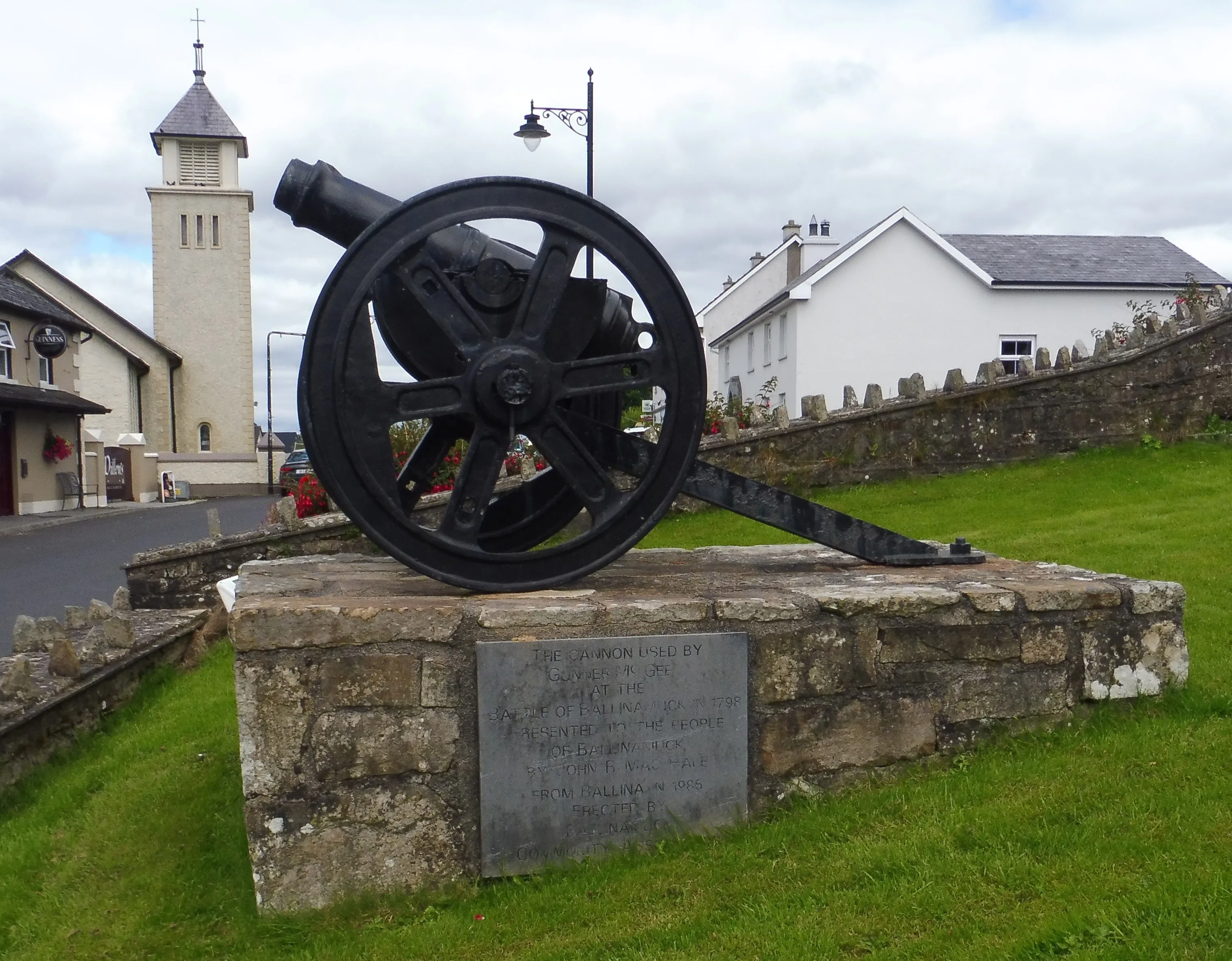
(Edward Bourke Photo)
Cast Iron possibly a 32-pounder 17-cwt Smoothbore Muzzleloading Carronade with a Blomefield pattern breeching ring, mounted on a wooden wheeled gun carriage,
In addition to paying homage to Saint Barbara, its patron saint, the Artillery Corps is unique within the Defence Forces, in that it has an historical figurehead, namely Gunner James Magee, from whom derives the Corps unique esprit de corps, its rich heritage, and its enduring values of professionalism, respect, loyalty, selflessness, physical courage, moral courage and integrity.
Since the establishment of the Artillery Corps on 23 May 1923, Gunner Magee’s courage, heroism, and resourcefulness have inspired gunners of all ranks, and his heroic stand during the Battle of Ballinamuck on Saturday 08 September 1798, has been commemorated and honoured by the Artillery Corps.
Arising from his defiant stand in Ballinamuck, Gunner Magee received national recognition in 1954, when the Government formally named the Military Barracks in Kildare Dún Uí MacAoidh (Magee Barracks), which garrisoned the Depot and School Artillery, and the 1 AA Regiment.
This reflects an appropriate tribute to Gunner Magee, recognising his resilience and unquestioning valour in the face of superior forces, a fact that is made all the more poignant considering the futility of his heroic stand.
The Magee Gun Trophy honours and commemorates the unquestioning courage of Gunner Magee and his gun crew, their resourcefulness in their ability to keep the gun in action, and their ultimate sacrifice for Ireland. Gunner Magee and his gun crew embodied those values which continue to inspire the present generations of Irish gunners of all ranks..
Honouring Gunner James Magee, the Artillery Club commissioned an oil on canvas painting of the “Battle of Ballinamuck” by Thomas Ryan PPRHA. Restored by Ciara Brennan MA in 2014, the painting is currently on loan to the 2 Artillery Regiment, and is on display in the Officers’ Mess, Custume Barracks Athlone.
Bangor, County Down, Northern Ireland

(Notafly Photo)

(Ross Photo)

(Alan Wright Photo)
Cast Iron possible 2-pounder Smoothbore Muzzleloading Gun, 1780, mounted on a wood naval stand in Ward Park, Bangor Abbey. This cannon taken from the Ulster Privateer 'The Amazon' that was wrecked in Ballyholme Bay on 23 February 1780.
Bangor Abbey was established by Saint Comgall in 558, and was famous for its learning and austere rule.

(BangorArt Photo)
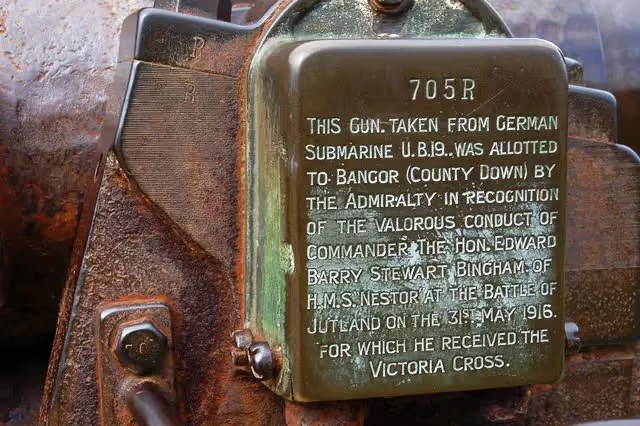

(Aubrey Dale Photo)

(Ross Photo)
German 10.5-cm deck gun, left-side breech end view. This gun was taken from German U-boat U-19 and is located in Bangor`s Ward Park. The gun was used in the Battle of Jutland.
Belfast, Northern Ireland

(Ardfern Photo)
Cast Iron possible 6-pounder Smoothbore Muzzleloading Gun mounted on a wood gun carriage, inside the Ulster Museum, Stranmillis Road.

(Ardfern Photo)
Cast Iron Smoothbore Muzzleloading Gun mounted on a wood gun carriage, inside the Ulster Museum, Stranmillis Road.


(NCDaywalker Photos)
Ordnance QF 25-pounder field gun, located in The Shankill Somme Memorial Park, Belfast, Northern Ireland.
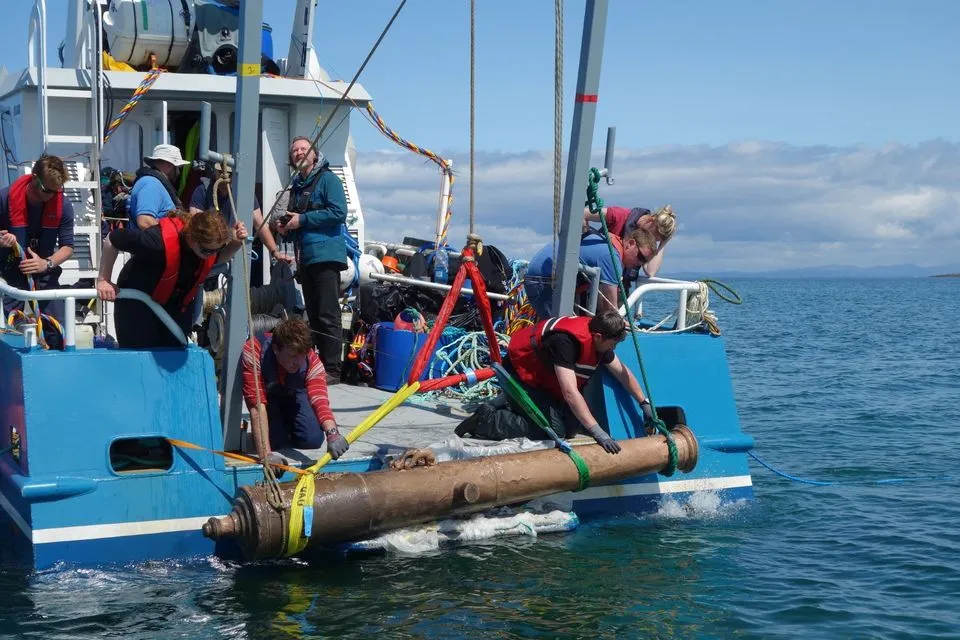
(Edward Bourke/Belfast Telegraph Photo)
Cannon from the Spanish shipwreck La Juliana.
Artefacts including six bronze cannon and a cauldron have been raised from the wreck of a Spanish Armada galleon off the coast of Co Sligo. The items are from La Juliana - one of three Armada ships shipwrecked off the coast at Streedagh in 1588. Winter storms over the past two years uncovered the treasure from the seabed and the cannon, a gun carriage wheel and cannon balls have now been recovered.
Archaeologist Finbar Moore said that the cannon were "in beautiful condition". La Juliana was a Catalan ship, built near Barcelona and commandeered for the Armada.
Derry, "Maiden City", Northern Ireland
_p187_VIEW_OF_LONDONDERRY_DURING_THE_SIEGE_OF_1688-89.webp)
(British Library Image)
View of Londonderry during the siege. The Bishops Gate with its drawbridge is in the centre.
The siege of Derry in 1689 was the first major event in the Williamite War in Ireland. The siege was preceded by an attempt against the town by Jacobite forces on 7 December 1688 that was foiled when 13 apprentices shut the gates. This was an act of rebellion against James II. The second attempt began on 18 April 1689 when James himself appeared before the walls with an Irish army led by Jacobite and French officers. The town was summoned to surrender but refused. The siege began. The besiegers tried to storm the walls, but failed. They then resorted to starving Derry. They raised the siege and left when supply ships broke through to the town. The siege lasted 105 days from 18 April to 1 August 1689. It is commemorated yearly by the Protestant community. (Wikipedia)
Cannon on the walls of the Maiden City
"The cast-iron guns of the Maiden City survived turbulent times. At a most basic level, they are ponderous lumps of cast iron made to wreak death and destruction. But step back a little, and their elegant forms and delicate mouldings contradict the intent of their users. In the wider context of the Atlantic archipelago in the last years of the 16th century and first half of the 17th, they demonstrate accelerating innovation and expertise in the production, manipulation and casting of large volumes of molten iron. In the 18th century, the quest to produce accurate bores gave rise to the technology that underpinned the development of the steam engine, a revolutionary new power source that brought mechanisation on an unprecedented scale. In short, these cannon bear witness to emergent technologies that later would be at the heart of the Industrial Revolution."
"Cast-iron cannon came from an industrial complex spanning the mining of iron ores, construction of charcoal-hungry blast furnaces, and the making of the clay moulds into which the molten metal was poured. The structures of the cast metal observed in this study reveal something of the strengths on which commanders could rely and the weaknesses of which gunners had to be aware of for their lives. But cannon without gunpowder could not fire, and without proper carriages as transport and stable firing platforms, they had no military value. Thus, for cannon to reach ramparts or battlefields required networks of miners, transporters, foundry men, saltpetre producers, sulphur importers, foresters, charcoal burners, clay diggers, blacksmiths, carpenters, wheelwrights, merchants, bankers and financiers, and armies of labourers. They fed a thriving arms trade – both legal and illegal– being produced and sold by some very flamboyant and colourful characters." (Guy Wilson, chairman, ICOMAM, The great guns like thunder: the cannon from the City of DerryB. G. Scott, R. R. Brown, A. G. Leacock and C. J. Salter(Guildhall Hall Press)

(WT-shared, Northern Counties Photo)

(Robert Finlay Photo)
17 Cast Iron Smoothbore Muzzleloading Guns mounted on wood naval carriages guard the city's ancient walls. (Derry is one of 52 walled towns in Ireland). The Siege of Derry (Irish: Léigear Dhoire) lasted from 18 April to 28 July 1689, during the Williamite War in Ireland. The city, a Williamite stronghold, was besieged by a Jacobite army until it was relieved by Royal Navy ships. Several guns manned by the defenders are displayed on different parts of city walls.
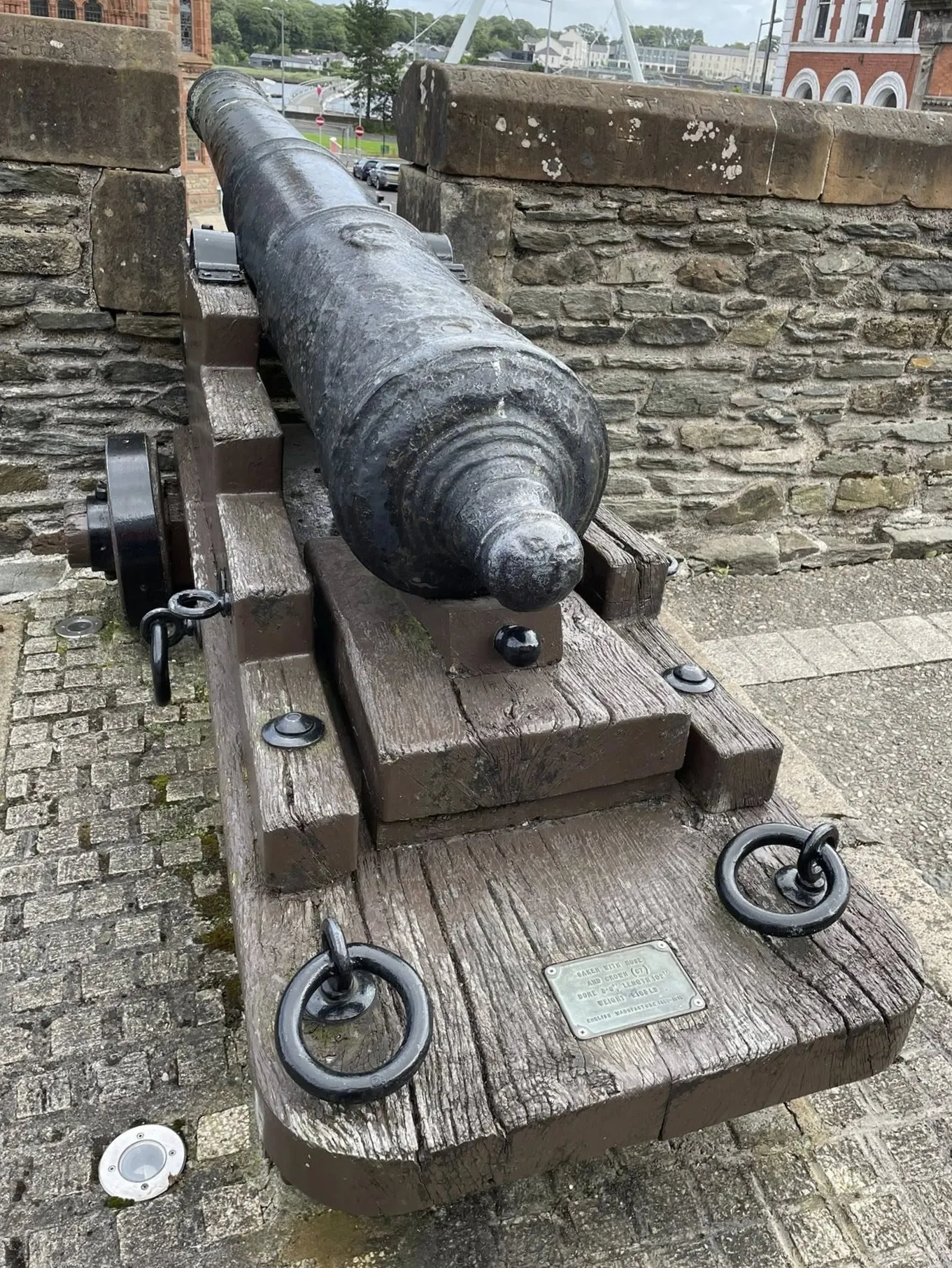
(Robert Finlay Photo)
Cast Iron Smoothbore Muzzleloading Gun, No. 1. Elizabethan Rose and Crown cypher, 17th Century.
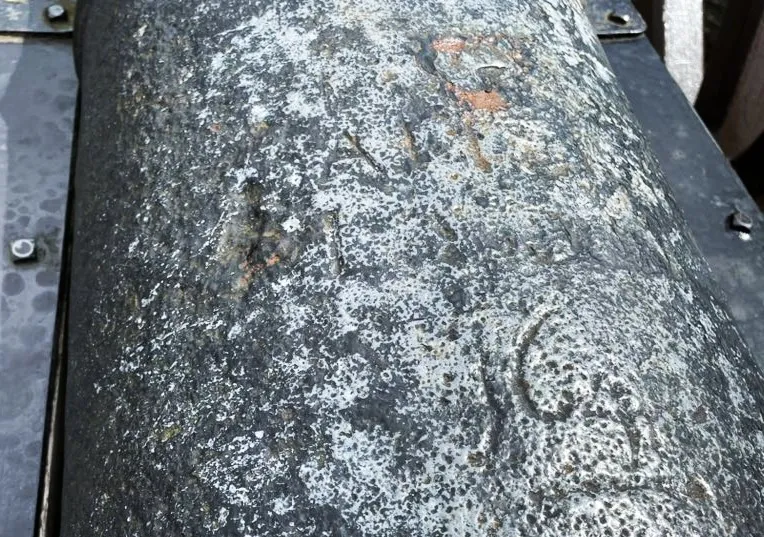
(Robert Finlay Photo)
Cast Iron Smoothbore Muzzleloading Gun, No. 2. Elizabethan Rose and Crown cypher, 17th Century.

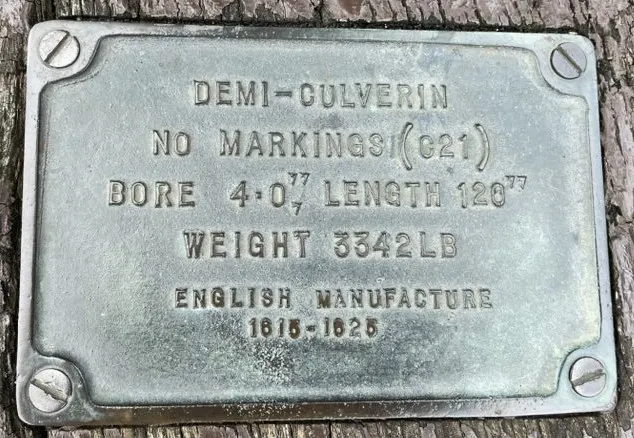
(Robert Finlay Photos)
Cast Iron Smoothbore Muzzleloading Gun, No. 3. Demi-Culverin made by Thomas Johnson, ordered by the earl of Essex in 1598 for Lough Foyle, via Sir Henry Bagenal in Dublin.
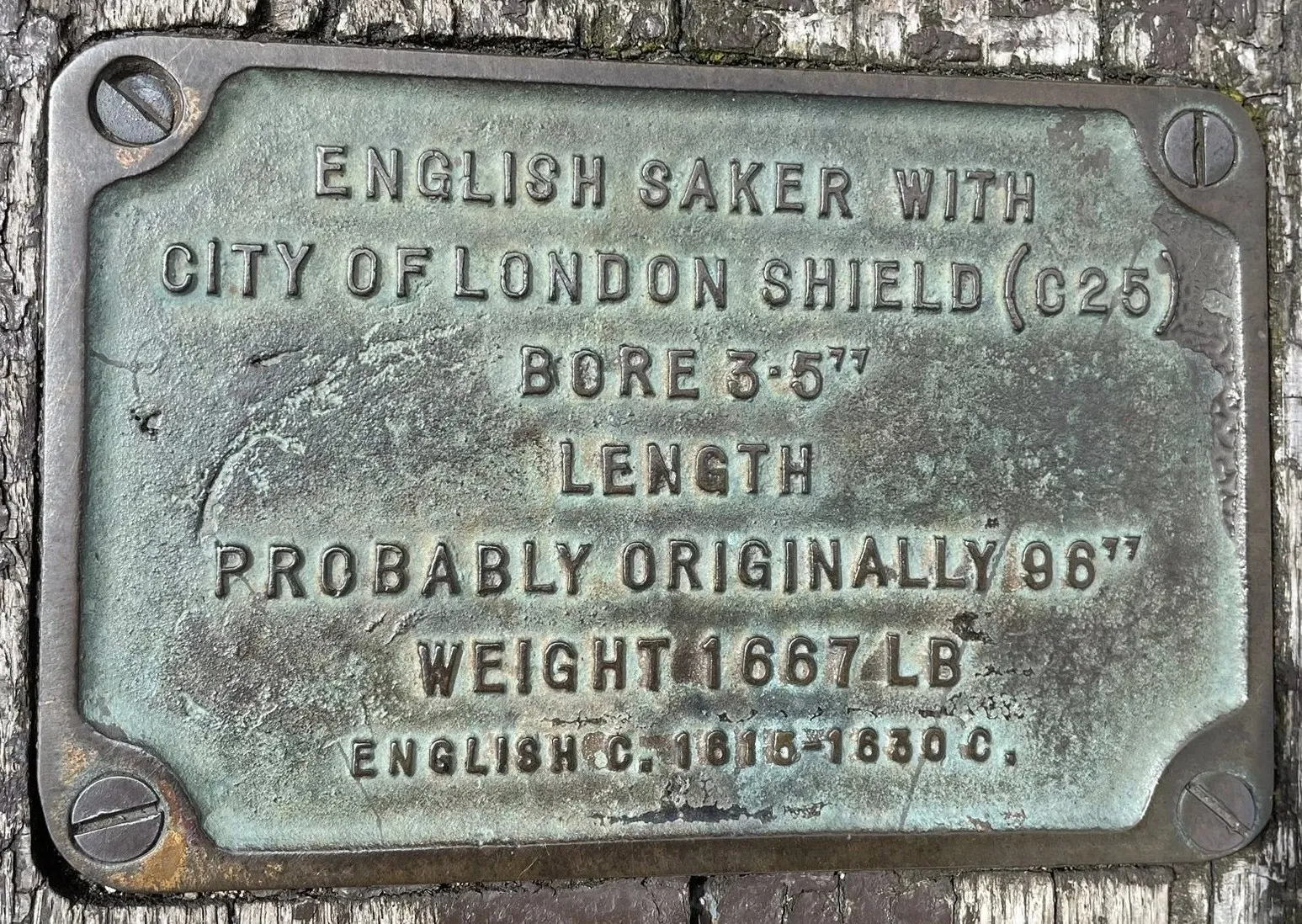
(Robert Finlay Photo)
Cast Iron Smoothbore Muzzleloading Gun, No. 4. Arms of the City of London cypher, almost certainly part of a consignment of ten cast-iron cannon sent for the defence of Culmore in 1620.
Cast Iron Smoothbore Muzzleloading Gun, No. 5. Arms of the City of London cypher, almost certainly part of a consignment of ten cast-iron cannon sent for the defence of Culmore in 1620.
Cast Iron Smoothbore Muzzleloading Gun, No. 6. Arms of the City of London cypher, almost certainly part of a consignment of ten cast-iron cannon sent for the defence of Culmore in 1620.
Cast Iron Smoothbore Muzzleloading Gun, No. 7. Arms of the City of London cypher, almost certainly part of a consignment of ten cast-iron cannon sent for the defence of Culmore in 1620.
Cast Iron Smoothbore Muzzleloading Gun, No. 8. Arms of the City of London cypher, almost certainly part of a consignment of ten cast-iron cannon sent for the defence of Culmore in 1620.
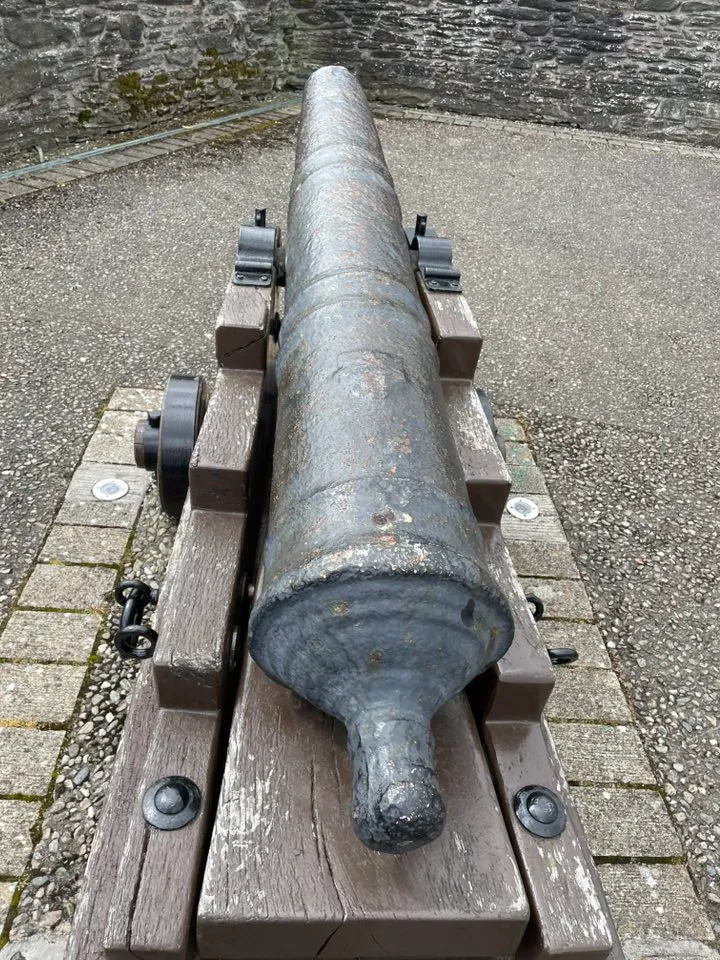
(Robert Finlay Photo)
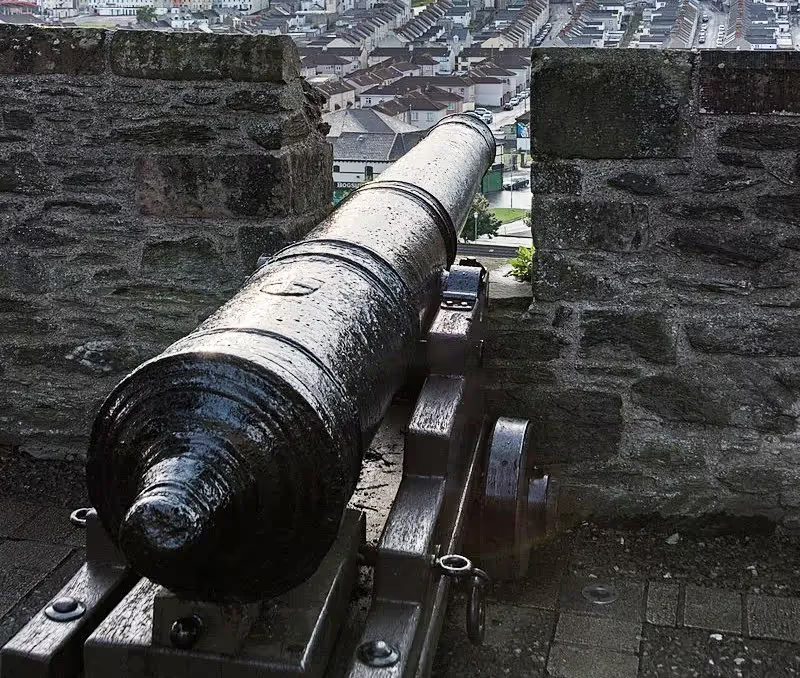
(Giorgio Galeotti Photo)
Cast Iron Smoothbore Muzzleloading Gun, No. 9. Demi-Culverin, Vintners of London cypher.
Cast Iron Smoothbore Muzzleloading Gun, No. 10. Demi-Culverin, Salters of London cypher.
Cast Iron Smoothbore Muzzleloading Gun, No. 11. Demi-Culverin, Fishmongers of London cypher.
Cast Iron Smoothbore Muzzleloading Gun, No. 12. Demi-Culverin, Mercers of London cypher.
Cast Iron Smoothbore Muzzleloading Gun, No. 13. Demi-Culverin, Grocers of London cypher.
Cast Iron Smoothbore Muzzleloading Gun, No. 14. Demi-Culverin, Merchant Taylors of London cypher.
Cast Iron Smoothbore Muzzleloading Gun, No. 15. Demi-Culverin, Merchant Taylors of London cypher.
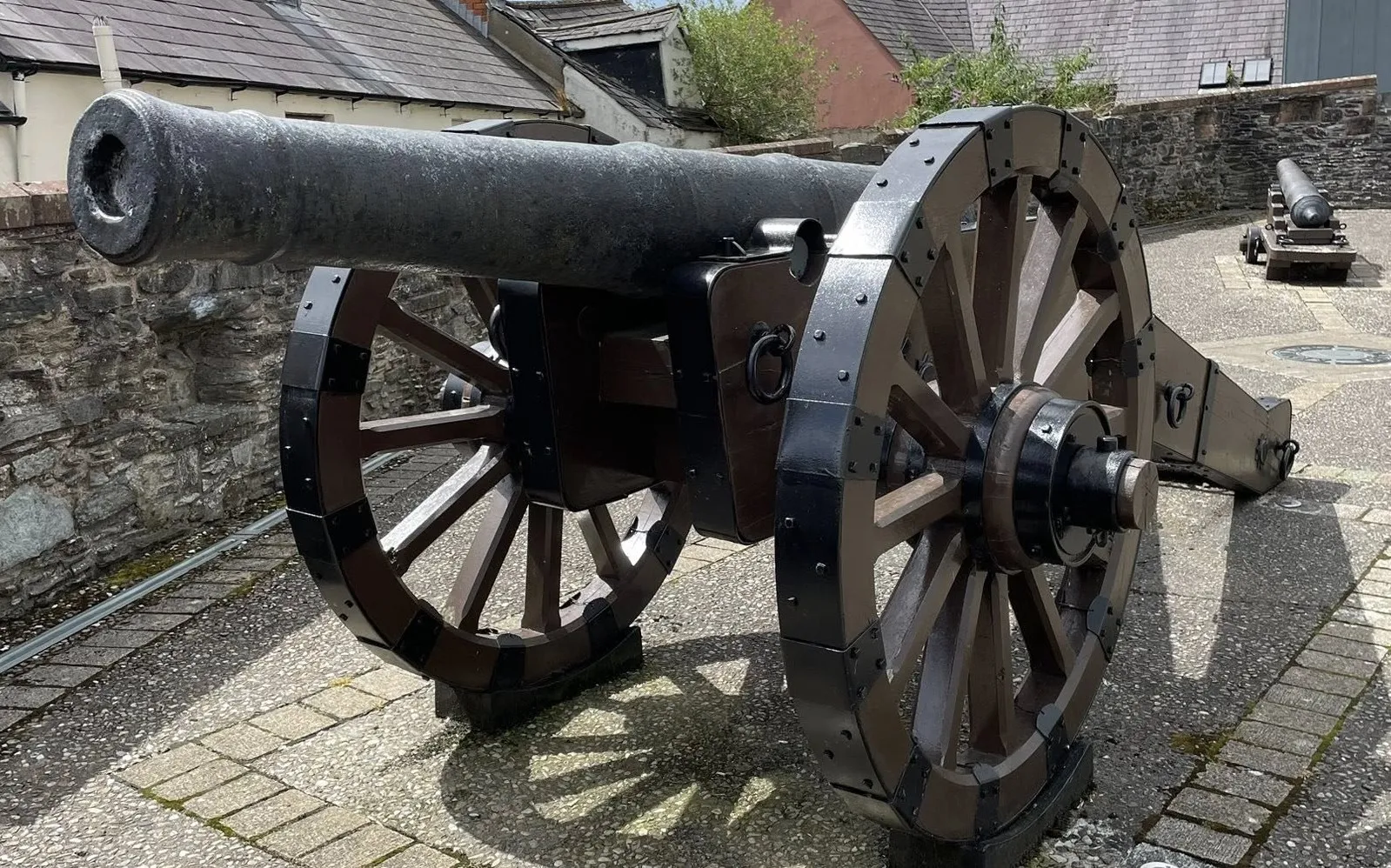
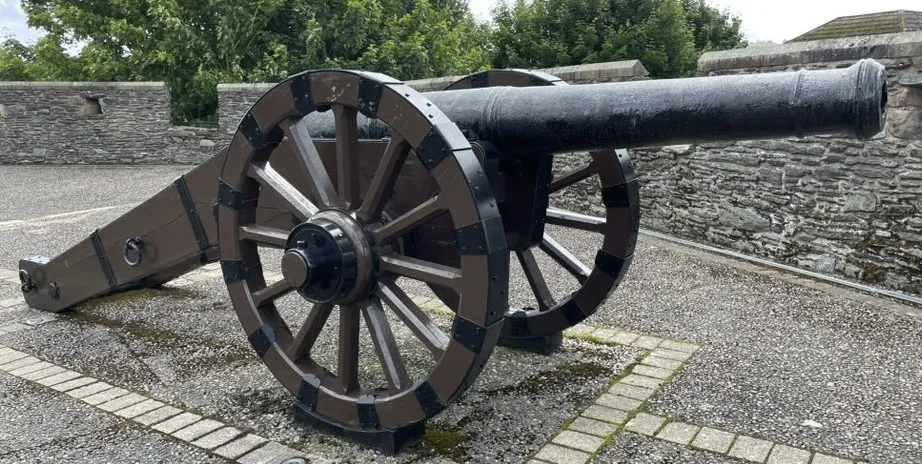
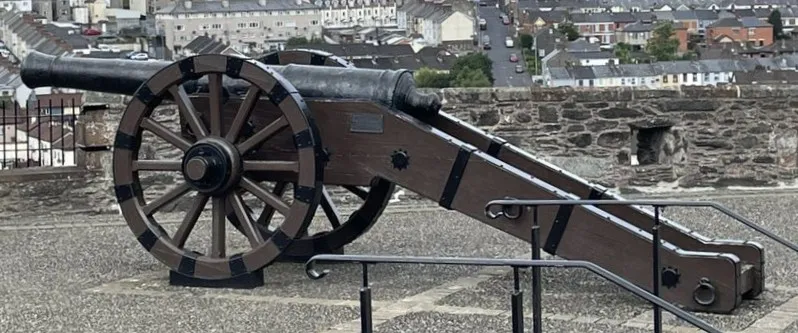
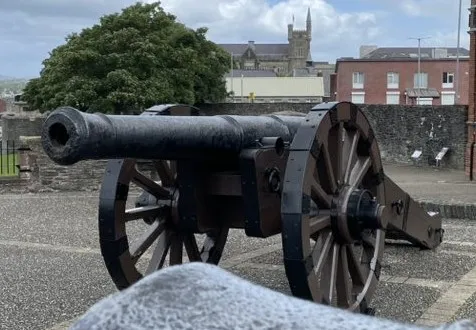
(Robert Finlay Photos)

(SeanMack Photo)

(Nicholas Raymond Photo)
Cast Iron 6-pounder Smoothbore Muzzleloading Gun, No. 16. Produced between c. 1773 and 1796 by John Wilkinson at Bersham, North Wales.

(Gav Connolly Photo)

(Romeparis Photo)
Cast Iron 6-pounder Smoothbore Muzzleloading Gun, No. 17. Produced between c. 1773 and 1796 by John Wilkinson at Bersham, North Wales.
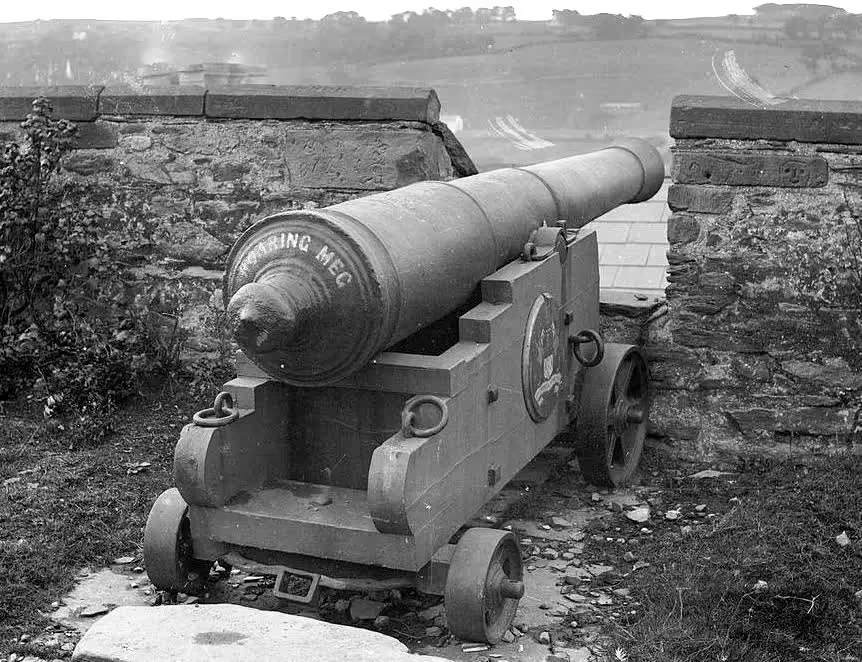
(National Library of Ireland Photo)
"Roaring Meg", named because of its ferocious sound in battle, was used during the Siege of Derry. One account of the famous cannon from the time of the Siege in the 17h Century said: "The noise of its discharge was more terrifying than the contents of the charge to the enemy." The barrel of the cannon bears the inscription "Fishmongers London 1642", marking the fact that it was one of 24 cannon sent to Derry by the City of London and the London Companies after the 1641 siege.
Fishmongers bought the demi-culverin "ready-made" so to speak from Samuel Ferrers, John Browne the gunfounder's London agent; he kept a store/warehouse and most of the Livery Companies bought their guns there for the plantation. Later the Fishmongers added a carriage and ammunition to their contribution. The records are quite clear it is a "demyculveryng"; most of the guns sent by the London livery companies in 1642 were all demi-culverins.
“Roaring Meg” is the most famous of the city of Londonderry’s collection of cannon. Part of a consignment sent from England in 1642 for the defence of the city after the outbreak of the 1641 Irish Rebellion, her purchas financed by the London Fishmongers Guild. She is a demi-culverin of 10 feet weighing in at 3955lb (1795kg) with a bore of 4.7 inches delivering a ball of maybe 15lb. The tube architecture is three stepped fields divided by two broad mouldings and a nicely flared muzzle. There are no markings on the trunnion faces but the first reinforce is marked “ Fishmongers London 1642”.
Derry~Londonderry, The Tower Museum, Union Hall Place
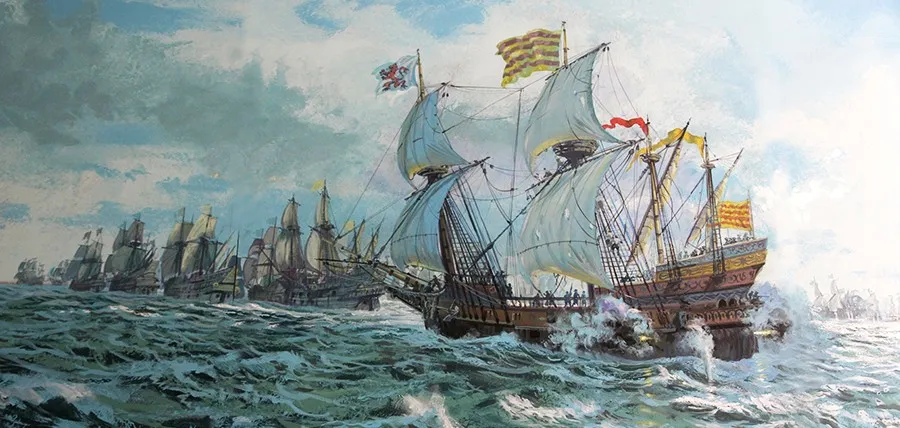
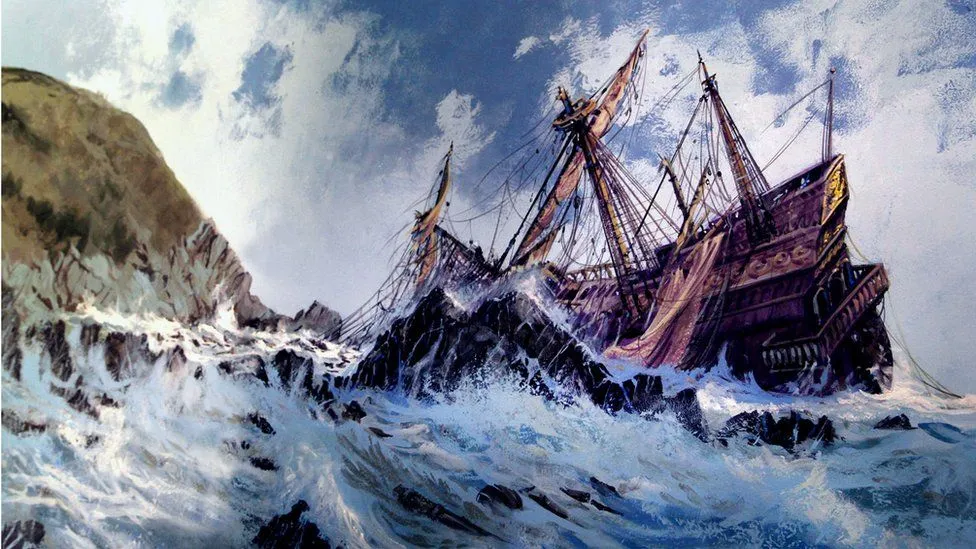
(The Tower Museum paintings)
The wreck of the 1100-tonne Venetian merchant ship La Trinidad Valencera, the fourth largest ship in the Spanish Armada, lost in 1588, was discovered on 20 February 1971. 13 divers from the City of Derry Sub Aqua Club found her final resting place in Kinnagoe Bay, off the Donegal coast, when they discovered a bronze cannon jutting out from the rocks. The vessel carried 360 men and was the most heavily armed ship of its time in the Mediterranean with 42 guns on board. It was badly damaged in a storm and had limped into anchor offshore on September 14th 1588 but sank two days later. Many artifacts have been recovered from this vessel and can be seen in the Tower Museum in Derry.
More than 300 sailors and soldiers, survivors of La Trinidad Valencera, were reputedly massacred by a force under the command of a Major Kelly, together with two English captains, the brothers Hovenden, somewhere between Elagh Castle and Burt, in September 1588. By contrast, Francisco de Cuéllar, a Spanish sea captain, who was wrecked with the Armada off Sligo, wrote warmly of the hospitality he received in the Derry area. In his memoir, ‘Captain Cuellar’s Adventures in Connacht and Ulster,’ written in Antwerp, in 1589, Cuéllar wrote of being welcomed by the Bishop of Derry, Redmond O’Gallagher, at Ó Catháin’s Castle on the river Roe. The artefacts recovered from the wreck were on display in the Tower Museum for 50 years. They will be moving to the new DNA Museum.
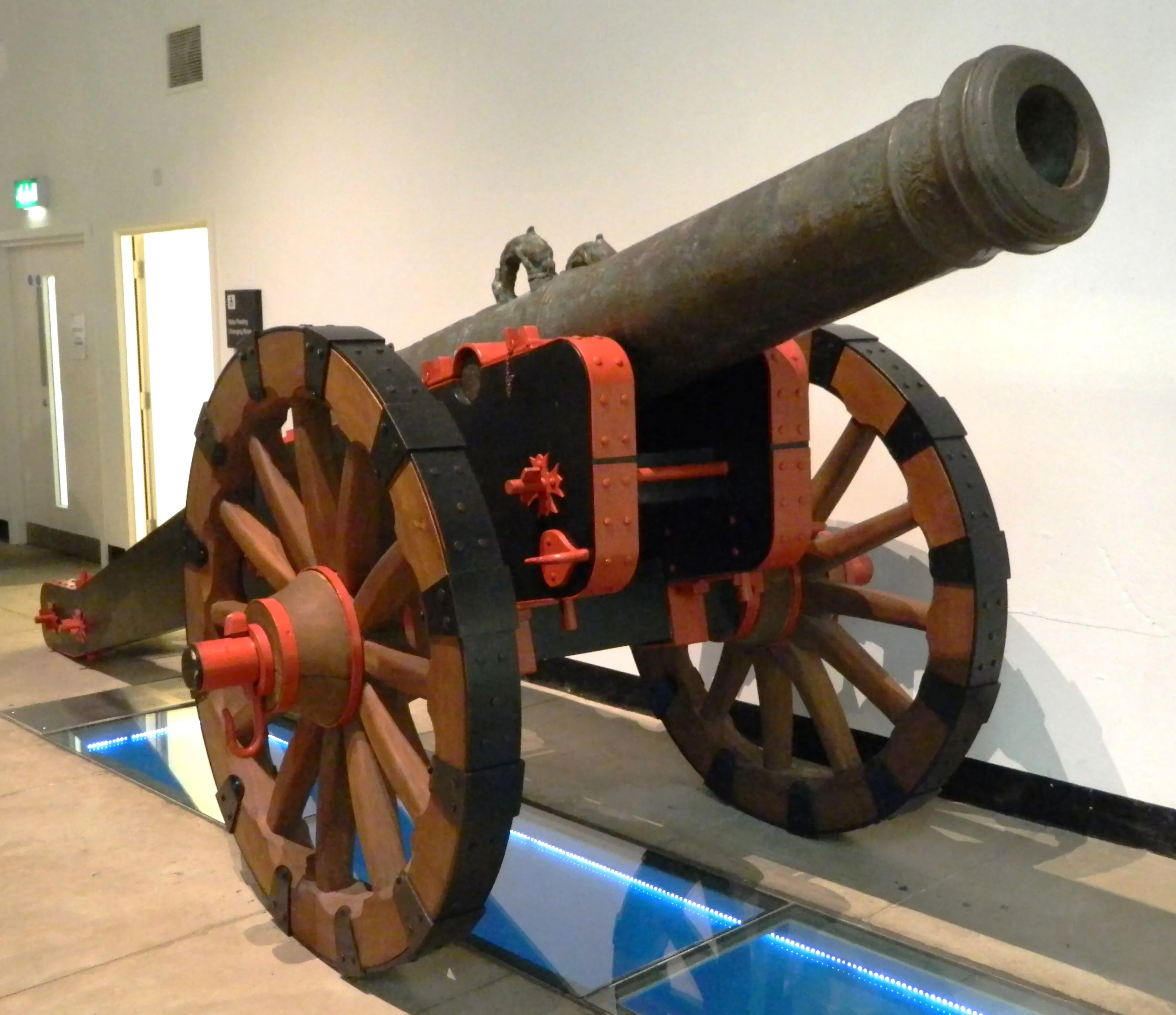
(Bazonka Photo)
Bronze smoothbore muzzleloading seige gun from the 1588 wreck of the Spanish Armada vessel La Trinidad Valencera, recovered from Glenagivney Bay, County Donegal in 1971. Displayed in the Ulster Museum.
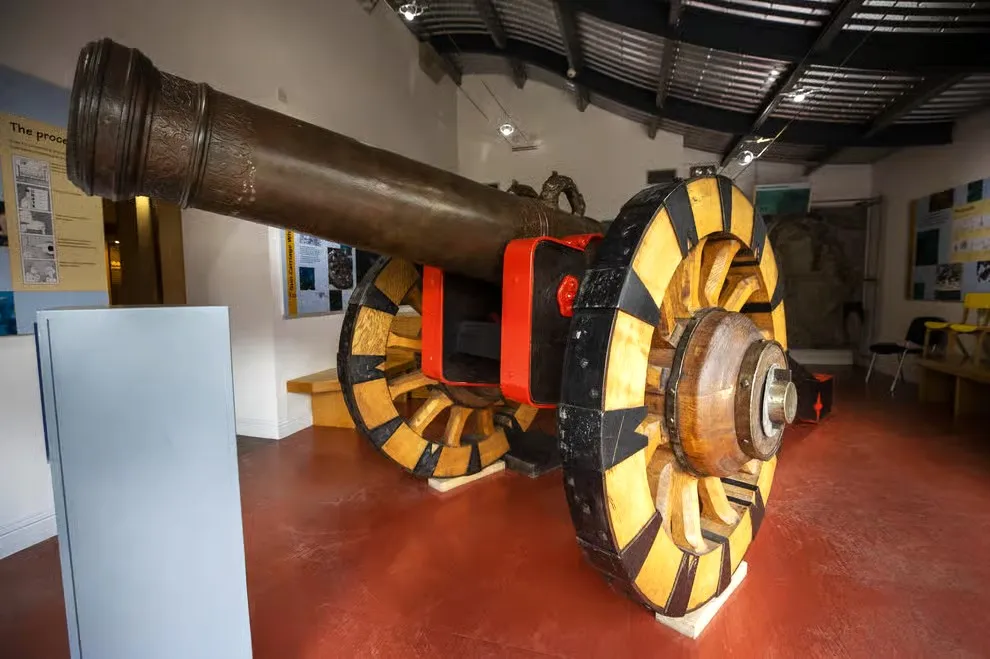
(Tower Museum Photo)
Bronze smoothbore muzzleloading seige gun from the 1588 wreck of the Spanish Armada vessel La Trinidad Valencera, on display at the Tower Museum in Derry City. This large bronze cannon is dated 1556 and bears King Philip of Spain’s coat of arms. It sits on a beautifully crafted replica gun carriage. An original wheel was found covered in solidified sand and silt. These siege cannons, with such enormous carriages and wheels, give evidence that the main intent of the Spanish Armada which was for a land invasion rather than a naval conflict.
King Philip gave the restoration of England to Catholicism as his reason for the invasion in 1588, but commercial and political objectives played a large part in it. Spain’s interests in the New World were increasingly under attack by the English and needed protection. Although it was one of the most ambitious military undertakings in history, the Spanish Armada was also one of the greatest failures. The ships were not only driven away by the English navy but were blown off course and scattered by strong gales. Many were wrecked off the coasts of Ireland and Scotland with a loss of one third of the vessels and two thirds of the men. With 42 guns, La Trinidad Valencera was the fourth largest ship in the Armada. She eventually reached Kinnegoe Bay, County Donegal, where she remained afloat for two days before breaking up and sinking, in September 1588. On 20th February 1971, she was discovered 150 metres offshore and 10 metres underwater by divers Archie Jack and Paddy Stewart, members of the City of Derry Sub-Aqua Club.
Most of La Trinidad Valenceria’s crew and soldiers got safely to shore. When they tried to negotiate an honourable surrender to the local militia, which was under English command, 300 of the 450 shipwrecked men were massacred. Sadly, only half of the 150 who escaped finally reached Spain. (Jean Reinhardt)
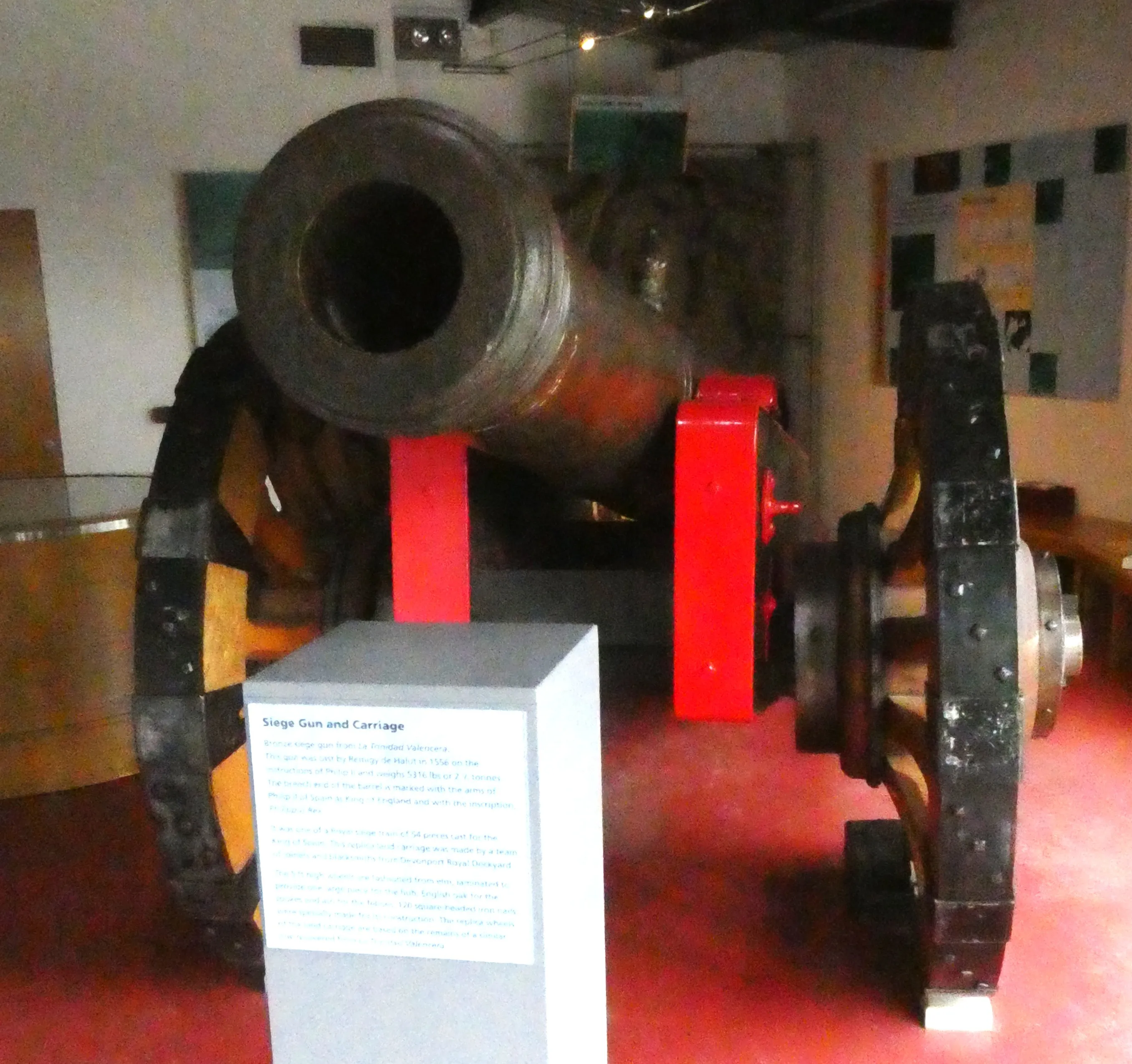
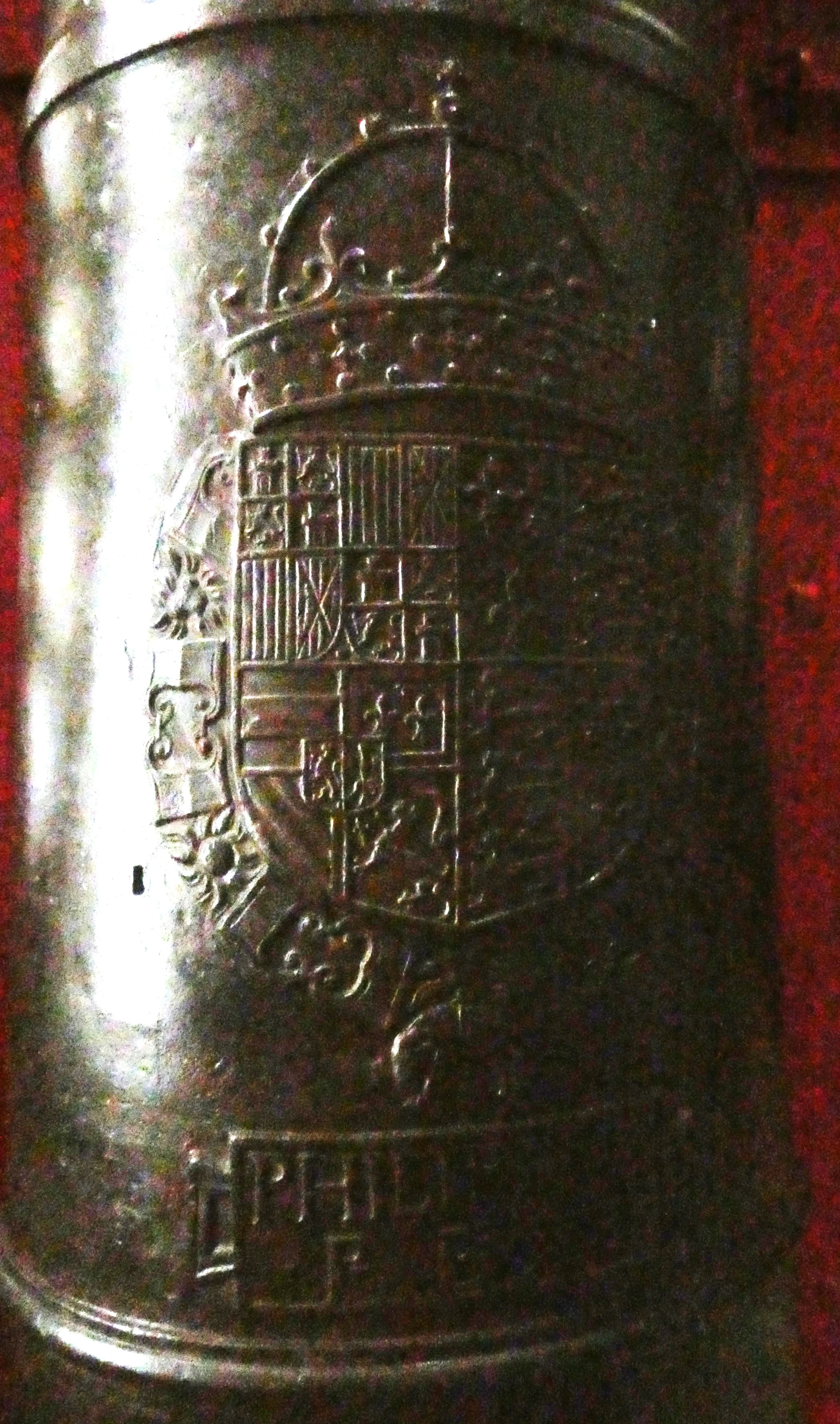
(Edward Bourke Photo)
Bronze SBML Gun from the 1100-tonne Venetian merchant ship La Trinidad Valencera, the fourth largest ship in the Spanish Armada, lost in 1588, on display in the Tower Museum.

(Alan Wright Photo)
Russian Cast Iron 24-pounder Smoothbore Muzzleloading Gun, a Crimean War Trophy mounted on an iron garrison carriage. This gun was captured at Sebastopol and installed in Derry City on 2 Jan 1860. Derry to have the most cannon of any European city.
Derry-Londonderry, Ebrington
Ebrington is a 29 acre former military heritage site located on the Foyle riverfront, connected to Derry-Londonderry City Centre across the Peace Bridge. The site was originally occupied by Jacobite Forces during the Siege of Derry and subsequently developed as a 10 acre ‘Star Fort’ in 1841. It played a significant role in both World Wars and was pivotal during the Battle of the Atlantic. It is surrounded by a scheduled monument Star Fort Wall, akin to the Walls across the City, and contains many 19th Century Listed and Retained Buildings that in recent times housed and trained submariners during the Cold War, when it was known as HMS Sea Eagle.

(Mindtrip Photo)
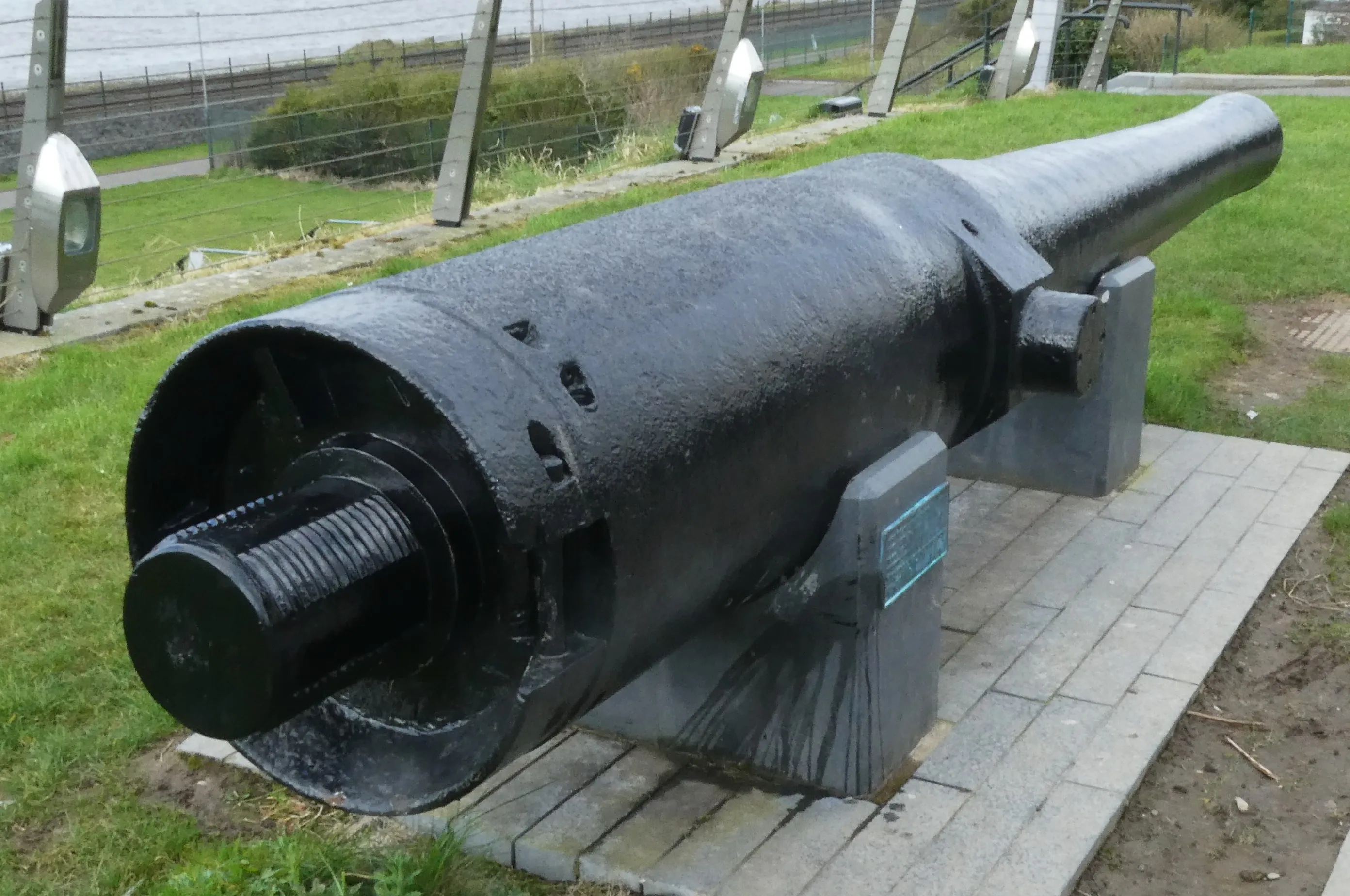
(Edward Bourke Photo)
Breechloading 6-inch Mk. VI Gun, introduced in 1894 and decommissioned in 1922. Recently unearthed on site, this gun may have come from Fort Dundee.
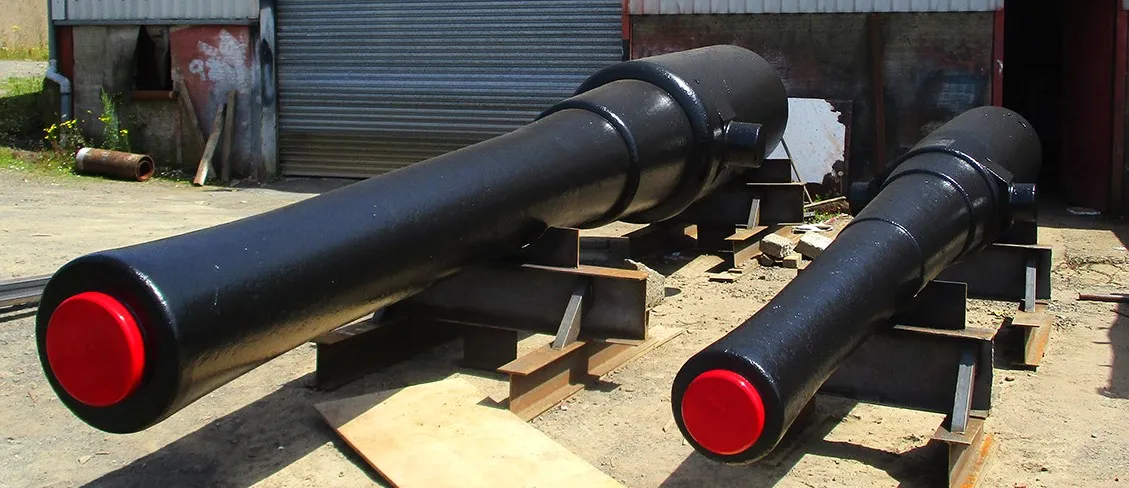
(Metalcast Photo)
Breechloading 6-inch Mk. VII Gun. Recently unearthed on site, this gun may have come from Fort Dundee.
Downpatrick, County Down, Northern Ireland
Downpatrick (from Irish Dún Pádraig, meaning 'Patrick's fort') is a town in County Down, Northern Ireland. It is on the Lecale peninsula, about 21 mi (34 km) south of Belfast. In the Middle Ages, it was the capital of the Dál Fiatach, the main ruling dynasty of Ulaid. Its cathedral is said to be the burial place of Saint Patrick. Today, it is the county town of Down and the joint headquarters of Newry, Mourne and Down District Council.
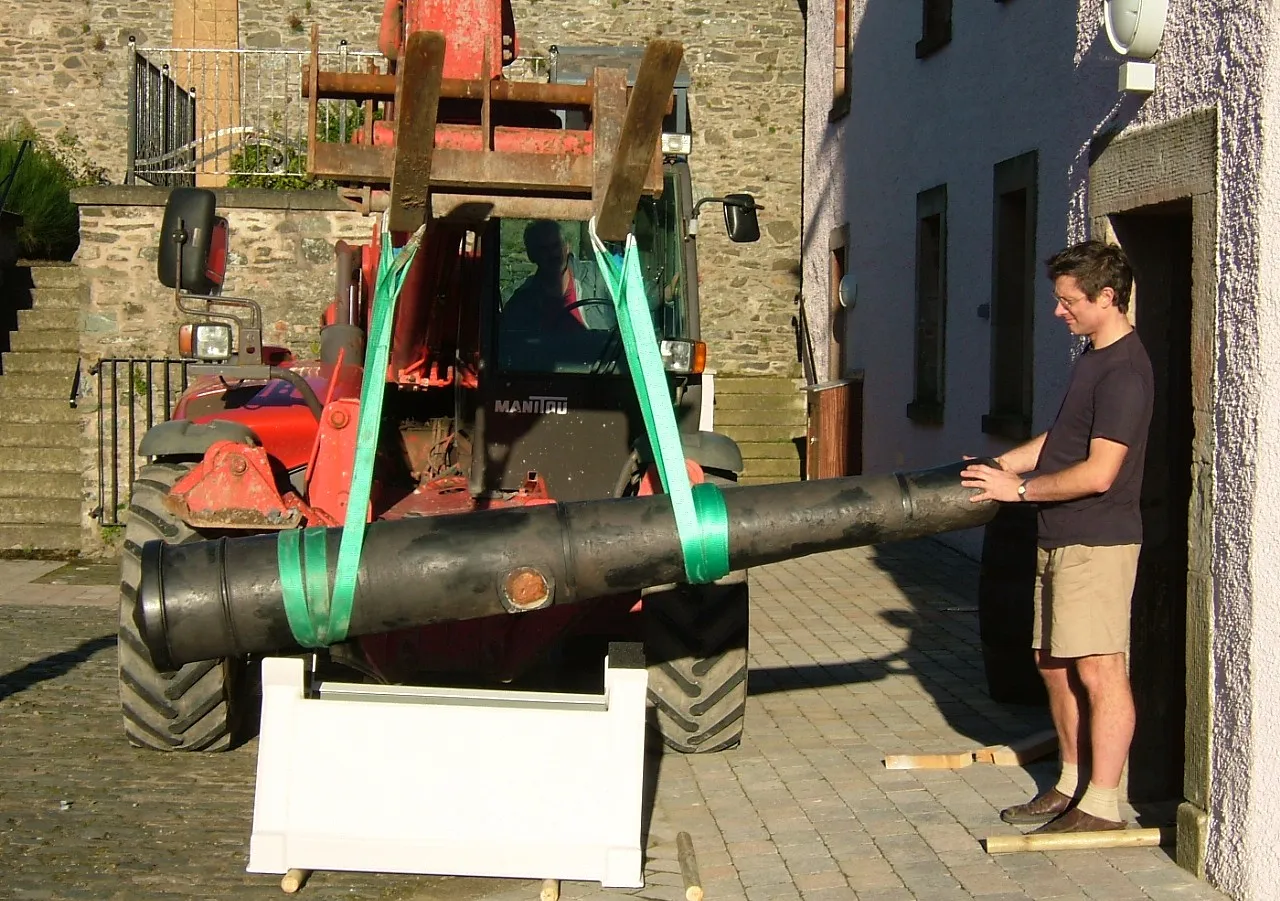
(Edward Bourke Photo)
This remote inlet was formerly the haunt of smugglers and gun runners. The French brigantine, L'Amitie, gun running for the United Irishmen in 1797, foundered here in a storm with the loss of 100 lives. This cannon was recovered from the ship and is preserved at Downpatrick's Down County Museum,
Grey Point Fort, Helens Bay, County Down, Northern Ireland

(Nick Photo)
Ordnance QF 25-pounder field gun.

(Nick Photo)
Breechloading 6-inch Mk. VII Gun on a Mk. II(L) CP Garrison Mounting No. 1 and No. 2 of 2, Crawfordsburn County Park.
Lisburn, County Antrim, Northern Ireland


(Notafly Photos)

(Pieces of History Photo)


(Ardfern Photos)
Russian Cast Iron 24-pounder Smoothbore Muzzleloading Gun, a Crimean War Trophy mounted on an iron garrison carriage. This gun was captured at Sebastopol and presented to the city in 1858. It is on display in the Castle gardens, Castle Street.
Newry, County Down, Northern Ireland
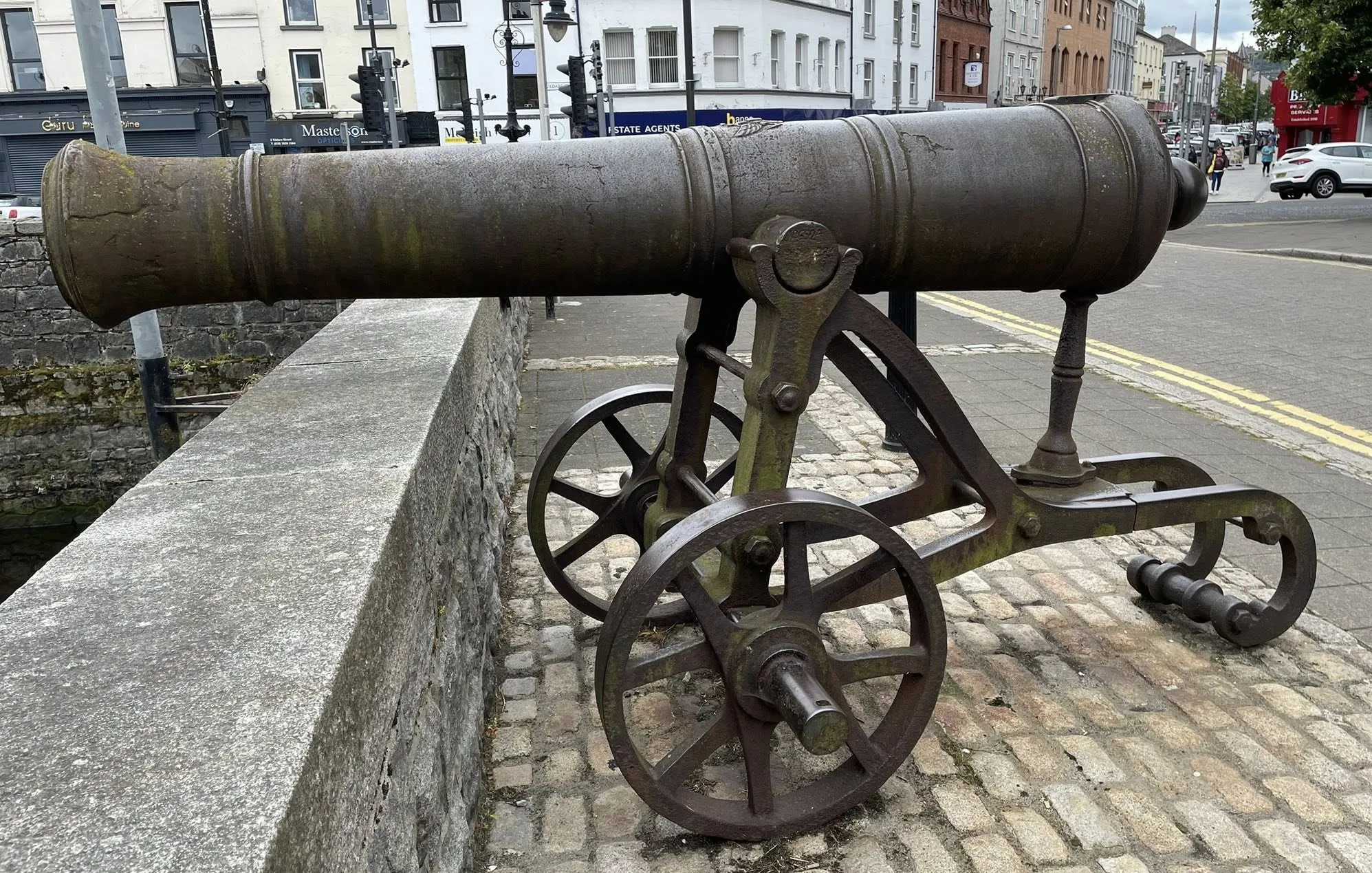
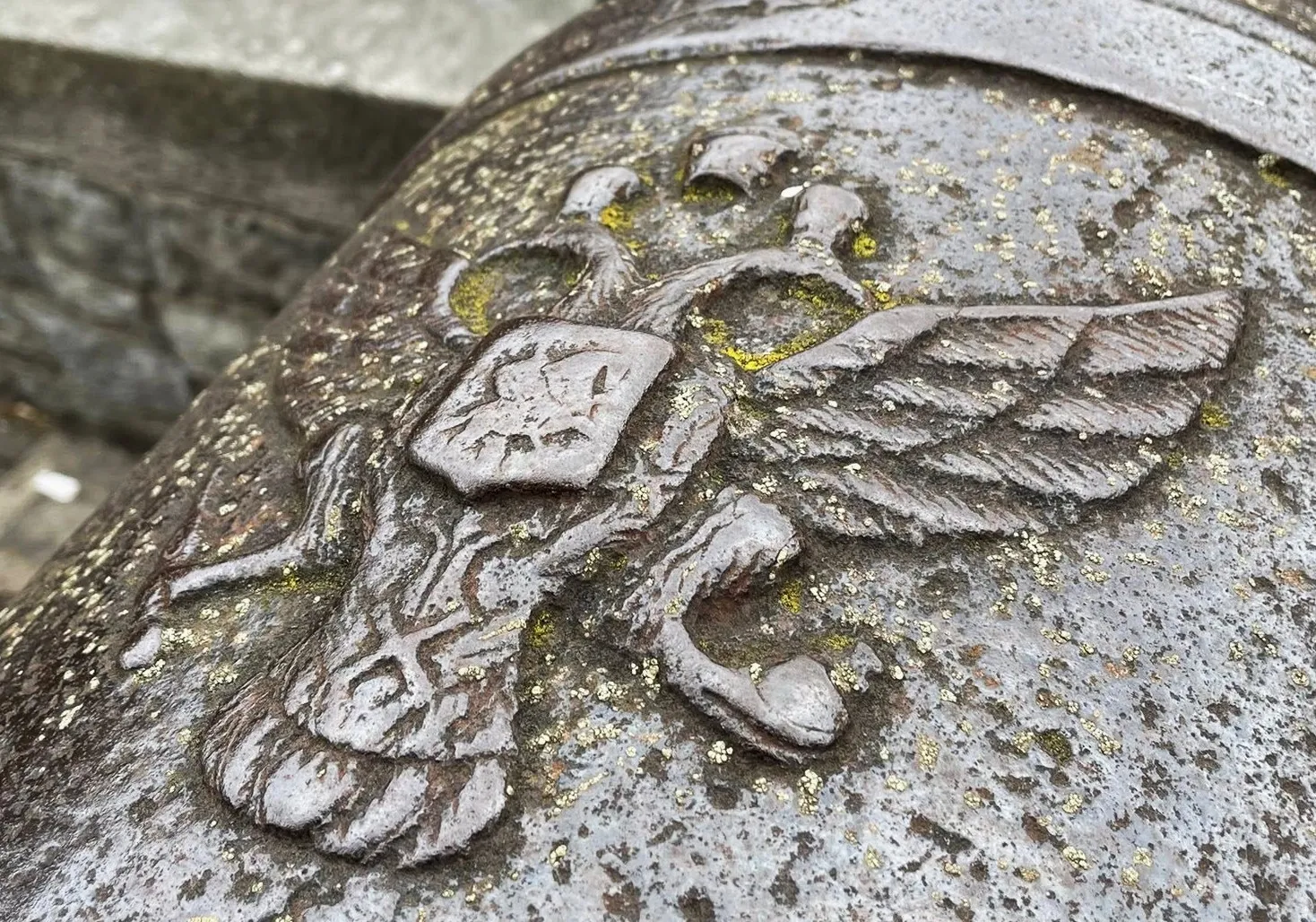
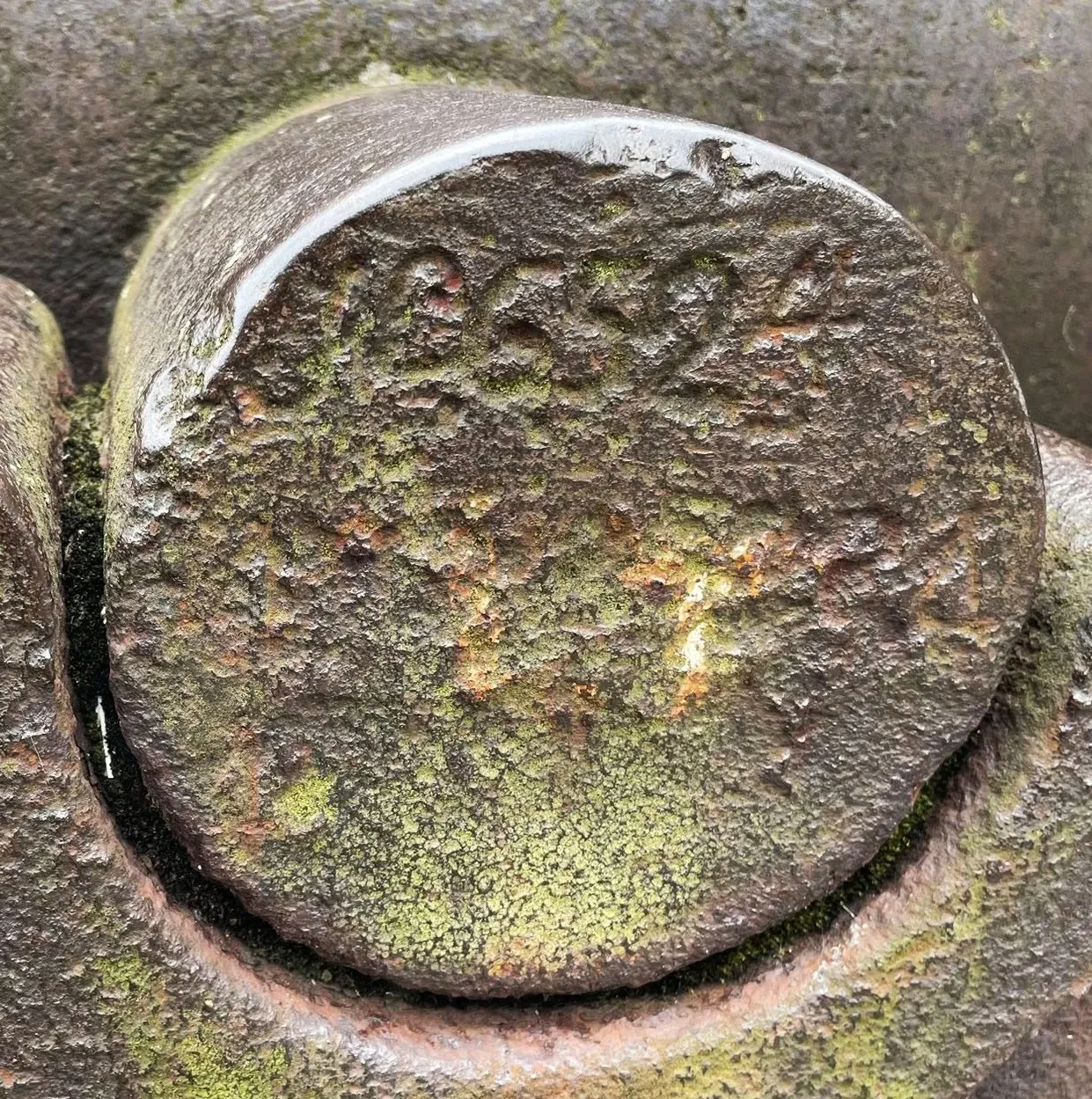
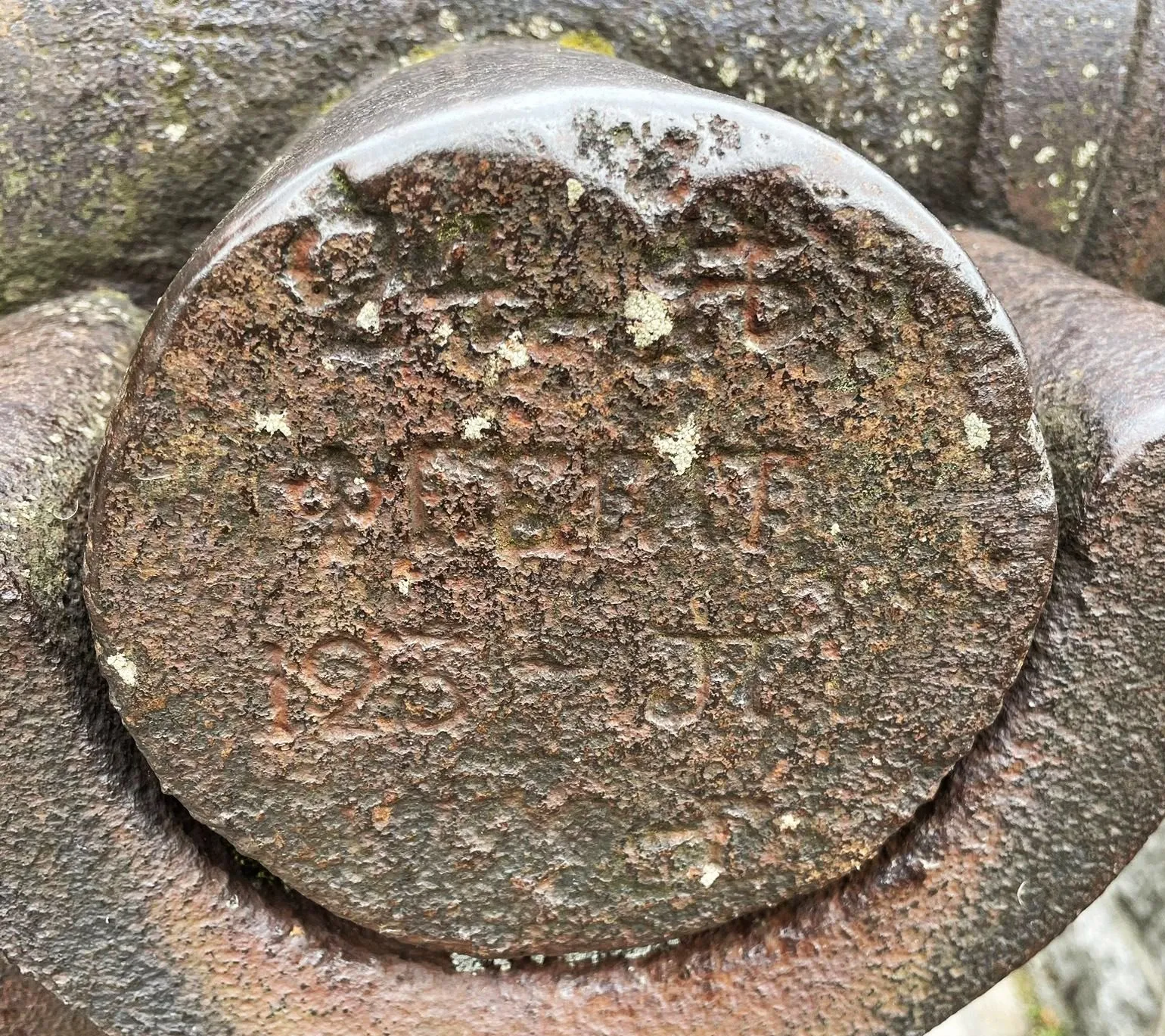
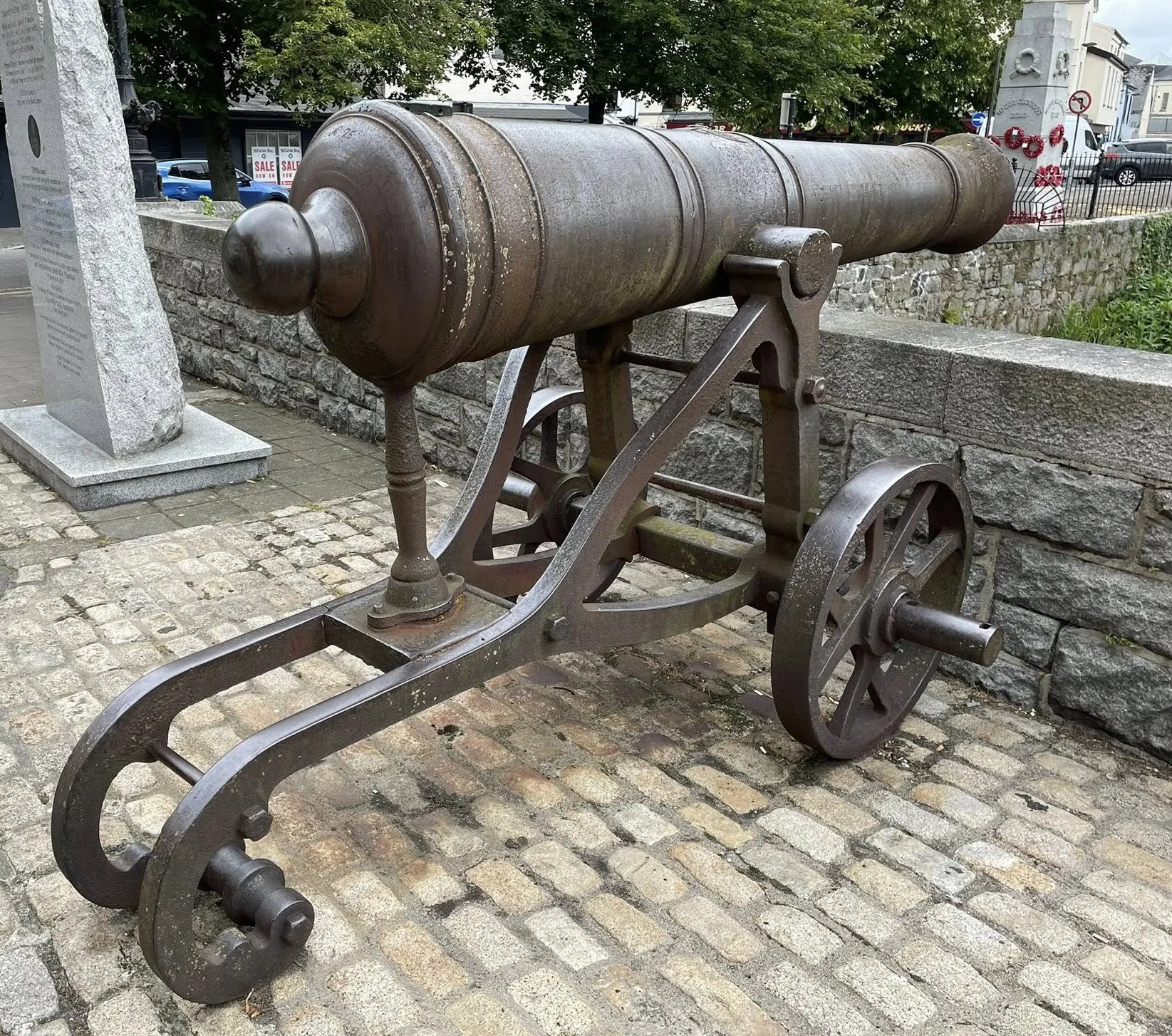
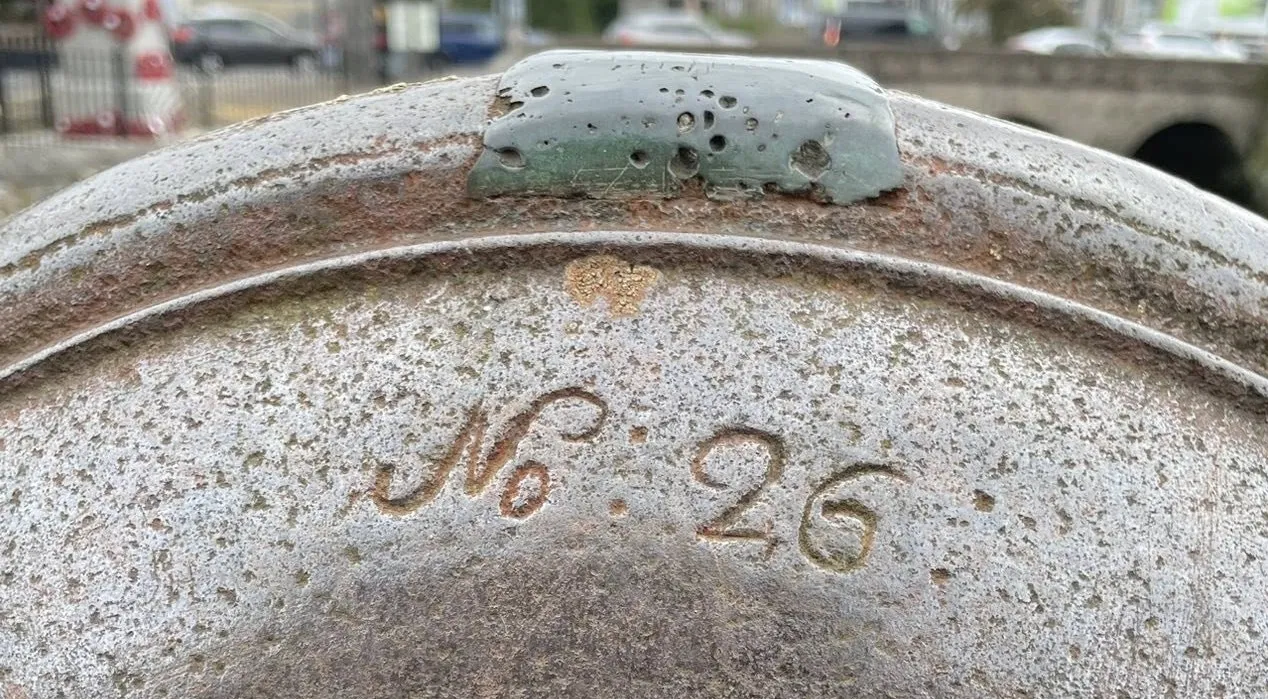
(Robert Finlay Photos)
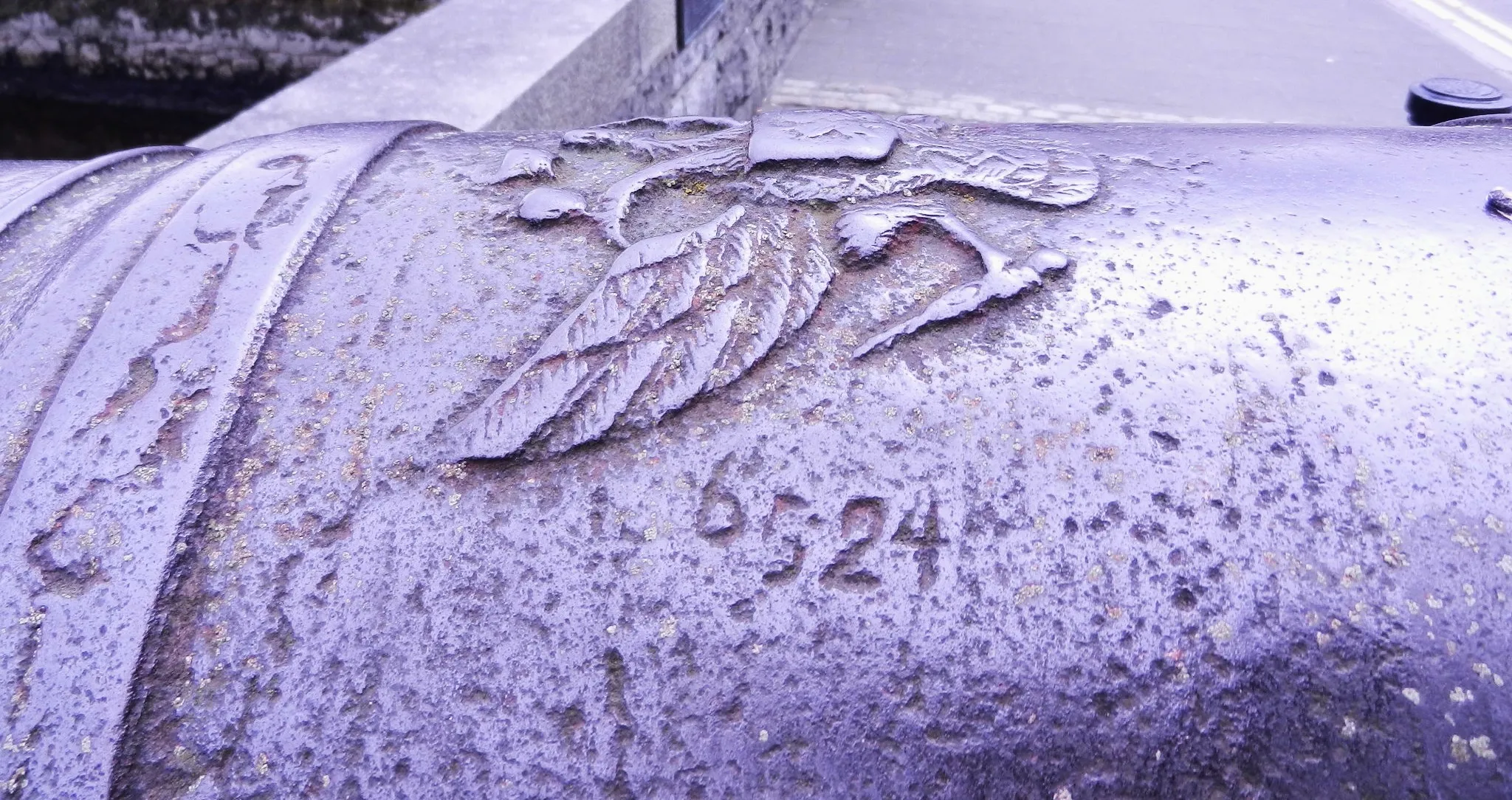
(Edward Bourke Photo)

(Ardfern Photo)
Russian Cast Iron 24-pounder Smoothbore Muzzleloading Gun, (possibly Serial No. 135624, corroded) on the left trunnion, possibly by Foullon at Alexandrovski, with double-headed Eagle on the barrel, mounted on an iron garrison gun carriage. This gun is a war trophy from the Crimean War, 1854-1855. Armagh Down Bridge, Bank Parade.

(Alan Wright Photo)
Cast Iron possible 12-pounder Smoothbore Muzzleloading Gun on a wood stand, roadside marker, A2 Newry to Warrenpoint Road.





